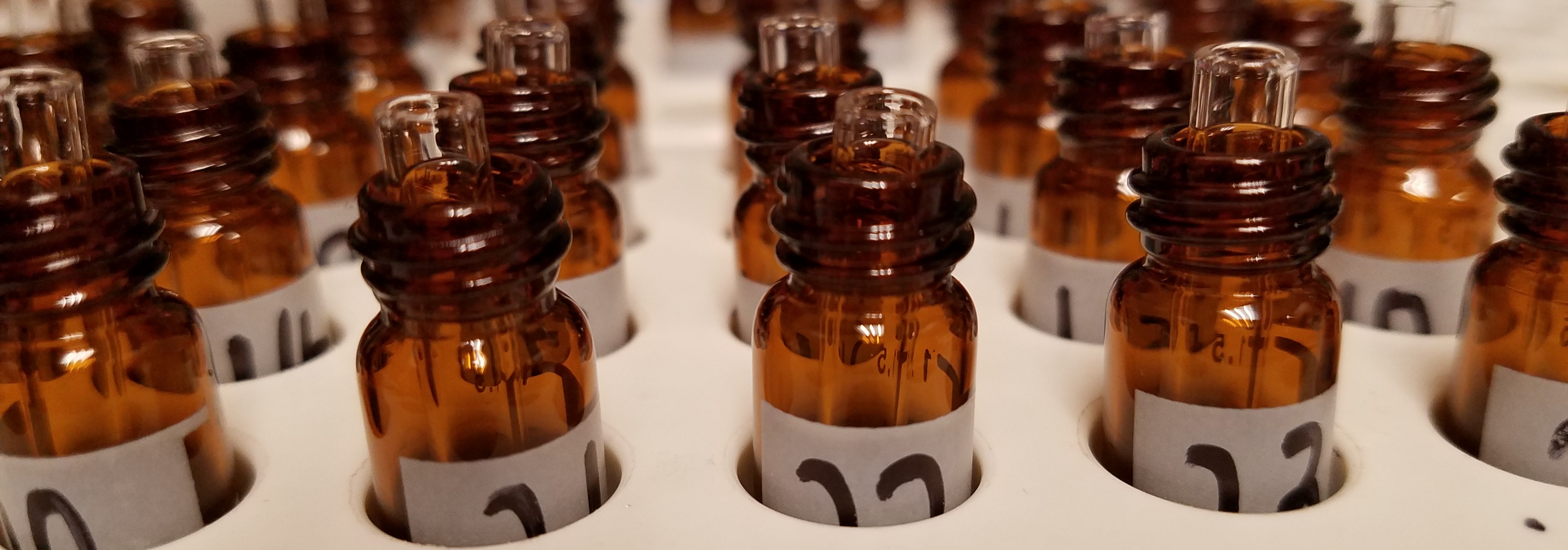The Bionutrition Core Laboratory has many well-established protocols for analyzing biomarkers of chronic disease, oxidative stress, metabolism, and antioxidant/phytochemical status from blood (plasma/serum), urine, tissues, and cells. Analytical technologies include LC-MS and (U)HPLC with ultraviolet/visible (UV/Vis), fluorescence (FL), and electrochemical (EC) detection. Some routine analyses include the following analytes. Please inquire for other established LC-MS/(U)HPLC services or for the possibilities of designing customized LC-MS/(U)HPLC services.
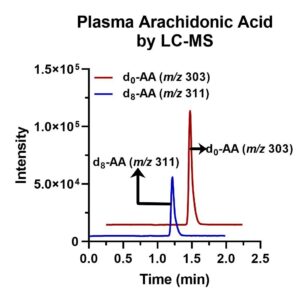
Arachidonic acid by LC-MS
- Arachidonic acid (C20:4 ω-6) is the precursor for the biosynthesis of various eicosansoids, including prostaglandins generated from the cyclooxygenase pathway and leukotrienes generated from the lipoyxgenase pathway. F2-isoprostanes, a biomarker of lipid peroxidation, are also generated from arachidonic acid in response to oxidative stress.
- Because eicosanoids and F2-isoprostanes are derived from arachidonic acid, and dietary, clinical, or pharmacological interventions can alter arachidonic acid metabolism, measures of arachidonic acid are important to aid in the interpretation of these arachidonic acid-derived metabolites.
- The Bionutrition Core Laboratory has established a high-throughput LC-MS procedure for arachidonic acid analysis.
Arginine and Vasoactive Metabolites by UHPLC-FL
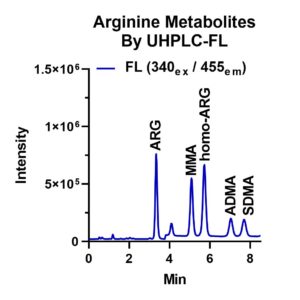
- An important function of arginine is that it is an essential precursor for the biosynthesis of nitric oxide, a critical determinant of vascular endothelial function. Dysregulated arginine metabolism, including that induced by oxidative stress, results in the excess accumulation of methylated metabolites that adversely impact nitric oxide homeostasis.
- Asymmetric dimethylarginine (ADMA) competitively inhibits nitric oxide synthase whereas symmetric dimethylarginine (SDMA) competes with arginine for endothelial cell uptake. Arginine is also the precursor for homoarginine (homo-ARG), and its low circulating levels are suggested to increase cardiovascular disease risk.
- The Bionutrition Core Laboratory has established an analytical procedure using solid phase extraction and UHPLC-FL detection for measures of arginine, its methy
- lated metabolites ADMA and SDMA, and homoarginine from a single specimen. This enables accurate assessment of arginine status, and normalization of ADMA, SDMA, and homo-ARG relative to arginine to enhance interpretation of altered physiological responses.
Homocysteine by HPLC-FL
- Homocysteine has received attention because its high accumulation is associated with cardiovascular disease, and its levels are closely related to inadequate status of folate, vitamin B6, and vitamin B12.
- The Bionutrition Core Laboratory has established a high-throughput HPLC-FL procedure to simultaneously measures plasma total homocysteine along with cysteine, reduced glutathione, and cysteinylglycine.
Malondialdehyde by HPLC-FL
- Malondialdehyde is among the most common oxidative stress-related measures of lipid peroxidation. Historical procedures for measures of malondialdehyde using spectrophotometric procedures have been criticized for their poor specificity and inaccuracy.
- The Bionutrition Core Laboratory has established an HPLC-FL procedure with high selectivity and accuracy for the measurement of malondialdehyde from tissues, cells, and blood (plasma).
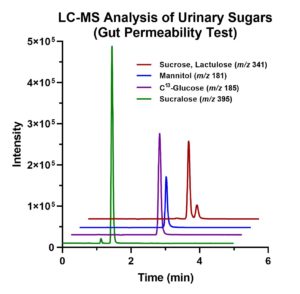
Gut Permeability Test by LC-MS
- Increased gut permeability (“leaky gut”) is implicated to contribute to low-grade inflammation by allowing for the uncontrolled absorption of bacteria or the cellular components such as lipopolysaccharide (i.e. endotoxin).
- Measures of gut permeability have historically focused on the evaluation of urinary elimination of lactulose and mannitol following their oral ingestion and calculating the urinary ratio of lactulose/mannitol. Recent advances in gut health measures indicate that gastrointestinal permeability can be assessed in a regiospecific manner following the oral administration of multiple sugar probes.
- The Bionutrition Core Laboratory has established an LC-MS procedure using a 5-probe sugar test to measure urinary sucrose (gastric permeability), lactulose and mannitol (intestinal permeability), and sucralose and erythritol (colonic permeability).
Vitamin C and Uric Acid by HPLC-ECD
- Ascorbic acid, or more commonly known as vitamin C, is an essential antioxidant and coenzyme for several hydroxylation reactions. It is the most abundant water-soluble antioxidant that is derived from the diet.
- Uric acid is implicated several chronic diseases when its levels are excessively high. However, normal levels of uric acid provide antioxidant function.
- The Bionutrition Core Laboratory has established a rapid procedure for the simultaneous measure of vitamin C and uric acid from blood (serum or plasma), tissues, and cells using HPLC-ECD.
Vitamin E (Tocopherols and Tocotrienols) by LC-MS, HPLC-FL, HPLC-UV/Vis, or HPLC-ECD
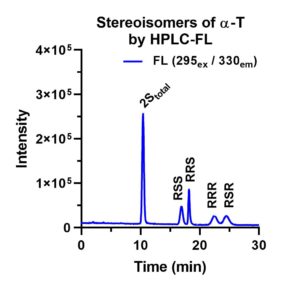
- Vitamin E is the term used to describe 4 tocopherols (α-, β-, γ-, δ-) and 4 corresponding tocotrienols.
- Under most dietary conditions, the predominant vitamin E forms present in tissues and circulation are α- and γ-tocopherol, and some dietary supplement users may have low circulating levels of other vitamin E forms.
- The Bionutrition Core Laboratory has multiple technologies available for measures of vitamin E from biological and non-biological sample matrices. We use a high-throughput procedure utilizing UHPLC-ECD for measures of α- and γ-tocopherol to address the needs of most customers. The HPLC-ECD procedure is readily adapted for measures of other vitamin E forms, including tocotrienols. HPLC-FL or -UV/Vis procedures are also available, and is commonly used for measures of vitamin E from non-biological sample matrices.
- The Bionutrition Core Laboratory also has an highly sensitive LC-MS procedure for measures of vitamin E, including deuterium labeled α-tocopherol that is commonly administered in controlled human trials.
Vitamin E (α-Tocopherol) Stereoisomers by HPLC-FL
- In nature, α-tocopherol exists in a single form: RRR-α-tocopherol. Because of the important antioxidant role of α-tocopherol, supplements are commonly used. Most dietary supplements contain an all racemic mixture of α-tocopherol that contains equal amounts of 8 unique stereoisomers of α-tocopherol: RRR-, RRS-, RSR-, RSS-, SRR-, SRS-, SSR-, SSS– .
- Only 50% of these stereoisomers are appreciably bioavailable and contribute to meeting dietary vitamin E requirements.
- The Bionutrition Core Laboratory has established HPLC-FL procedure utilizing chiral separation and detection by fluorescence to quantify total 2S stereoisomers (SRR-, SRS-, SSR-, SSS-) and individual 2R stereoisomers (RRR-, RRS-, RSR-, RSS– ) of α-tocopherol.

Vitamin E Metabolites by LC-MS
- Excess α-tocopherol and non-α-tocopherol forms of vitamin E are catabolized in a cytochrome P450-dependent manner. The mostly commonly detected metabolites are α-carboyxethyl-hydroxychromanol (α-CEHC) and γ-CEHC.
- The Bionutrition Core Laboratory utilizes an LC-MS procedure to measure urinary and circulating α- and γ-CEHCs.

